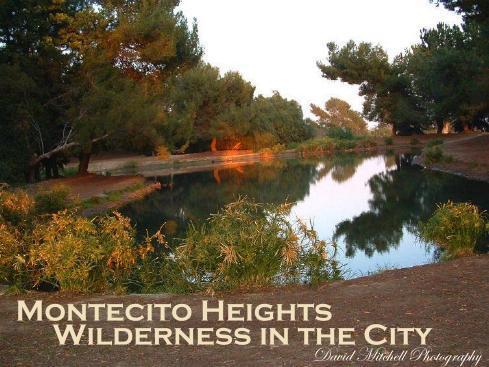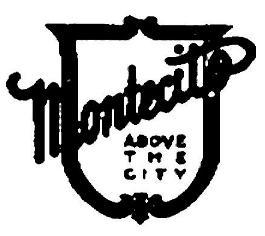Montecito Heights
Our Information
- Contact List
- Our contact information...
- Newsletter Archive
- Post Your Newsletter
About Us
Montecito Heights

Montecito Heights above the City
The community of Montecito Heights, located between Los Angeles and Pasadena, has attracted artists, visionaries and intelligentsia for nearly a century. This picturesque district possesses a rich history as one of the oldest and most fascinating sections of Los Angeles. To read the fascinating life story of the elusive region of Los Angeles which enchanted Aimee Semple McPherson and cured Charles Lummis?’ wanderlust, click here or on "History" anywhere in these pages.
Montecito Heights area attractions include Heritage Square?’s collection of meticulously restored Victorian houses, the notable Lummis Home, the famed Southwest Museum (Los Angeles?’ first museum), and the astonishingly vast Ernest E. Debs Regional Park. The Audubon Society has expressed an interest in Debs Park, and community leaders who wish preserve Debs as an authentic native wilderness area have joined with Audubon to study the creation of a park bird sanctuary.
Montecito Heights?’ prime location, a pleasant ten minute drive from downtown Los Angeles, not only adds hours to the waking life of any former commuter, it also makes for fabulous and convenient sightseeing, whether entertaining one?’s guests or oneself. The treasures enfolded in the boundaries of downtown Los Angeles are too numerous to list, but here are a few: MOCA (Museum of Contemporary Art), Olvera Street, Chinatown, Little Tokyo, the L.A. Children?’s Museum, the historic Angel?’s Flight trolley that links the Grand Central Market to California Plaza's astonishing water sculptures, Dodger Stadium, the palatial Los Angeles Central Library, and the newly renovated Union Station. For a great list of downtown sites, click here.
Of course, the throb of a close and vigorous colossal urban center makes the exquisite natural haven of Montecito Heights seem like paradise to hard-working residents. And to native wild creatures, it truly is a paradise. Songbirds abound, and many migratory birds have selected lovely Montecito Heights as an interim destination in their long journeys. The skies above Montecito Heights would look bare to her residents without containing at least one soaring red-tailed hawk. Coyotes occasionally sing their eerie midnight hunt songs, though they rarely show themselves. Great white owls occasionally make spectacular appearances, swooping past on their enormous wings; and many endangered trap-door spiders make their homes in the Montecito Heights brush lands. For more information about our secret Eden, check out the nature page of the Montecito Heights .
Wilderness in the City
Spend a night in Montecito Heights, and you will awaken in the morning to a lavish chorus of bird songs. An amazing profusion of birds make their homes in the hillside grasslands and native trees of our little nature sanctuary. Even more birds stop by during their yearly migrations. Ruby and green throated hummingbirds (very abundant), house finches, towhee, red-tailed hawk all thrive here and, of course, so do mockingbirds that do every one?’s material just a little bit better than the originals. In the spring and fall, red-breasted robins appear, along with many others.
In the summer, when you rise and go outside to enjoy the sunshine, you might glimpse some shy native California Alligator lizards, beneficial creatures found all over Montecito Heights. The ?“gentle lizard?” referred to in the Wizard of Oz song must have been a California Alligator lizard; these guys not only have easy-going temperaments, they are practically defenseless. They work hard keeping the insect population down, and make beautiful living garden ornaments.
One of the more fascinating species to make their homes among the brush in the Montecito Heights hills are trap-door spiders. These spiders are related to the tarantula, and make burrows lined with silk and covered with a silk hinged cap. Their surprise attack combined with the spider?’s small amount of venom makes them an infallible predator to ants and other small insects.
Many Montecito Heights residents have the rare luxury of being able to pretend that they live in the secluded countryside. Due to the hills on which our community is built, quite a few houses, modest in every other respect, possess splendid vistas where nothing is visible except bare nature. A new home owner can feel enormous joy in watching the moon rise over her broad lands, with nothing beyond her boundaries but prairie hills and quiet.
These hills are not always quiet. Because of the large amount of virgin land in Montecito Heights, coyotes manage to be well-behaved for the most part, and conceal themselves properly. They have never been known to actually enter a resident?’s yard. But occasionally, maybe once every couple of months, the coyote glee club whips up an amazing chorus of yelps. This eerie and spectacular song has become, oddly, one of my favorite things about living here. As I lie in my cozy bed feeling safe and snug, I listen to the coyotes?’ song and feel glad for once about the Big City I usually pretend doesn?’t exist. I also remind myself that a coyote?’s diet primarily consists of rodents.
A wild predator very common in Montecito Heights is the red-tailed hawk. These marvelous creatures can catch small birds on the wing, but dine mostly on rodents. One of the most spectacular moments in the LA Zoo ?“World of Birds?” show comes when this behavior is displayed. Hawks can live for many years, but only a small percentage of them live past their first year, mostly due to gunshot wounds or becoming entangled in power lines. In Montecito Heights, with constant Arroyo Seco water supply and our vast stretches of open hunting land, these babies do just fine, and the hawk population here has remained constant and vigorous for many many years.
Montecito Heights residents take their environmental custodianship role extremely seriously. We are proud to be the home of the pioneer, multi-million dollar Urban Nature Center built by the Audubon Society. This is a prototype facility, and its success will determine whether Audubon will open further urban nature centers.
A Rich History
The community of Montecito Heights, located between Los Angeles and Pasadena overlooking the Arroyo Seco River, boasts huge tracts of open wilderness areas, historic homes and magnificent views. This picturesque district possesses a rich history as one of the oldest and most fascinating sections of Los Angeles. The Arroyo Seco River, once lush and vibrant (and the subject of vigorous revitalization efforts), became a guide to the padres as they traveled the Old Monterey Trail from the San Gabriel to the San Fernando Mission. In the 1880s, a small settlement sprang up along the Arroyo Seco River, and the Old Monterey Trail eventually became a route of the Santa Fe Railroad. Currently, the Arroyo Seco Bikeway Project proposing a toll-road restricted to bicycles connecting Pasadena to downtown Los Angeles, seeks to create a "serious alternative to motorized commuting, designed to attract people of all ages and abilities".
Montecito Heights, due to its spectacular beauty and incredibly convenient location, has attracted creative and artistic Angelenos since the turn of the century. Eccentric journalist Charles Lummis traveled cross-country on foot from Cincinnati until he found his ideal spot -- bordering the Arroyo Seco River at Montecito Heights. There, he used his own hands to build his dream house from local river rock and called it El Alisal, Spanish for the giant sycamore growing beside the house. The site is now commonly referred to as "The Lummis Home". Charles Lummis founded the Southwest Museum, opened to the public in 1914.
In the thirties, evangelist Aimee Semple McPherson fell in love with a large tract of land in Montecito Heights that is still owned by her Four Square Gospel Church.
William Lees Judson, a prominent English painter, settled in the Montecito Heights area in 1893. There, along the banks of the Arroyo Seco, he founded the first school of fine art in Southern California, the Los Angeles College of Fine Arts. In 1901, the College of Fine Arts joined the University of Southern California and erected a building designed by Judson. The school and its founder attracted many artists and became known as the bohemian arts colony of the Arroyo Seco. The Judson Studios building also served as the guild hall for the Arroyo Guild of Fellow Craftsman, a group of artisans and craftspersons inspired by Judson and George Wharton James. In October 1909, influenced by William Morris, the Stickley brothers and the Roycroft community, James published the "Arroyo Craftsman" through the Arroyo Guild Press. The Craftsman aesthetic immediately enjoyed enormous esteem, popularized the budding Arts and Crafts movement of the 1920s, and advanced the American Bungalow architectural style, which is still highly revered.
Intrigued by the pragmatic and graceful Arts and Crafts style, free-thinking students came from all over the west and created a nurturing community of artists and writers. This artisan and intellectual community still thrives today. Because of this richness of artists and works, the Arroyo Arts Collective and the Historical Society of Southern California sponsor an annual "Museums of the Arroyo Discovery Tour" that highlights the local art and architecture for this and neighboring communities. Over fifty local artists participate each year in the event, now in its sixth year.
One of the more interesting characters to take up residence in Highland Park during the emergence of the Arts & Crafts era was Clyde Browne. Browne spent a decade building the Abbey San Encino, a lovely neo-Franciscan structure where he envisioned an arts collective comprised of the best printers, bookbinders, and graphic artists of his day, all of them living and working together under one roof. Boasting a tile fireplace designed by the legendary Ernest Batchelder, the Abbey must have been inspiring indeed. If such a dream can be measured by the accomplishments of its alumni, Clyde Browne was successful indeed - the Abbey was the childhood home of Jackson Browne, the incredibly talented musician whose songwriting defined American pop.
Montecito Heights itself began as a development in 1910. The developers envisioned the planned and affluent suburb they named Montecito Hills as groups of gracious houses placed on large lots surrounding a magnificent hilltop hotel. The company went bankrupt along with the rest of the country in 1929, and the hotel was never built. But many Montecito Heights residents still enjoy the legacy of the developers' vision, and delight in their spacious oversized lots, a rare luxury in any large city. Others have profited by becoming micro-developers and building second houses on their large tracts.
Email us
heavenly@pacbell.net
Links
Montecito Heights' Official Website
Arroyo Seco Neighborhood Council Website
About our association

Montecito Heights Improvement Association
The Montecito Heights Improvement Association has operated for over two decades with the goal of protecting the historic integrity, preserving the natural beauty and advancing the progress of this little gem of a neighborhood.
Links
Montecito Heights' Official Website
Arroyo Seco Neighborhood Council Website


